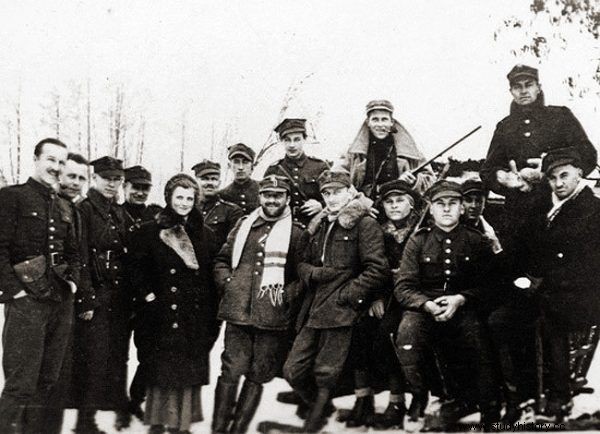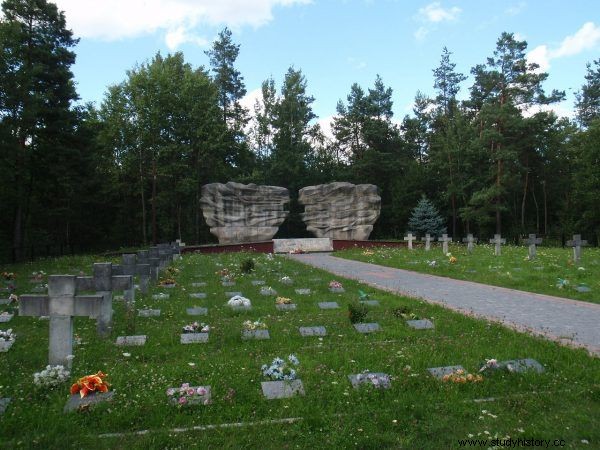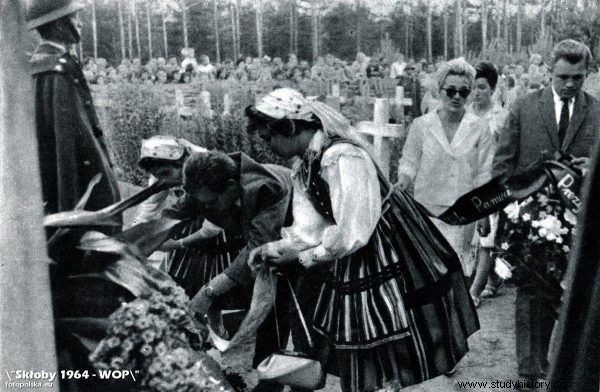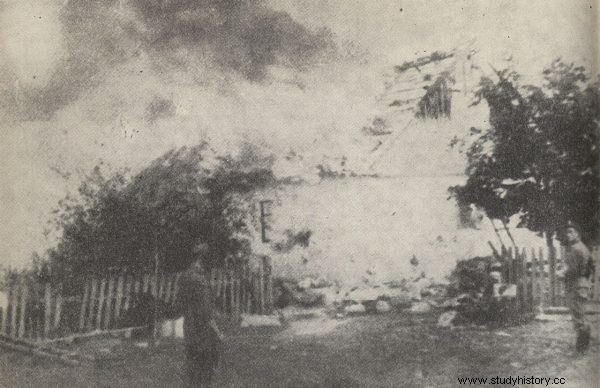More than 10,000 Polish villages and settlements were affected by various forms of repression by the German occupier. In over 900 localities, German security formations murdered from several to several hundred inhabitants. Over 440 villages in the General Government and the Białystok region were pacified, more than half of which were burned down.
Fighting the invader? We instinctively think about the Varsovians and the uprising, about the armed actions of the underground and guerrilla skirmishes. It is much too easy for us to forget that the Polish countryside was also against the Germans. And on a huge scale.
It was from the village that the Peasant Battalions, the second most militarily armed force of the Polish underground, originated. In the countryside, the surviving members of the Polish Army units, soldiers of the Home Army and the communist partisans:the People's Guard and the People's Army also found shelter and supplies. And the Polish countryside paid a considerable price for this sacrifice.
More than 10,000 settlements have been affected by various forms of repression. In over 900 localities, German security formations murdered from several to several hundred inhabitants. More than 440 villages in the General Government and the Białystok region were pacified, more than half of which were burnt. Only between mid-1942 and mid-1944, the Germans murdered about 50,000 Poles in pacification actions , mostly in the Lublin and Kielce regions, in places where partisan units were most active.

The first retaliatory actions were carried out by the Germans in revenge for the activities of the branch of Major Henryk Dobrzański "Hubal".
Retaliation for Hubal
The first pacification actions in occupied Poland were carried out by the Germans in retaliation for the activities of the Division of the Separated Polish Army, Major Henryk Dobrzański "Hubal". The last soldier of the Commonwealth after the fall of the Motherland did not lay down his arms. He operated with his unit in the Świętokrzyska Forest, between Końskie, Opoczno and Sulejów. The detachment, with the support of local peasants who provided it with food, small craft services and accommodation when needed, harassed the Germans, winning over them in several minor skirmishes.
The occupant engaged large forces in tracking down the "Mad Major" group. It was about 5,000–8,000 Wehrmacht and SS soldiers. The pacification of the area where "Hubal" operated began on March 30, 1940. Until April 11, as a result of brutal actions by German forces , 31 Polish towns were hit, in which 712 inhabitants died. A further several hundred people, often previously horribly tortured, were arrested and sent to forced labor or concentration camps.
German repressions covered, inter alia, villages:Adamów, Gałki Krzczonowskie, Hucisko, Królewiec, Mechlin, Małachów, Piekło, Smyków, Stadnicka Wola, Stefanków, Szałas Stary. However, the invaders committed the most brutal crime in the village of Skelki.
Halt! Polnische Banditen!
On the night of April 11, 1940, the town was surrounded by a tight cordon of German police and Selbstschutz. The inhabitants of Skłoby had heard rumors about a pacification that was about to take place, but they were not believed, while they were still preparing for Easter. The Germans began to methodically comb the farms, shouting "raus", "schnell" and using rifle butts to chase the inhabitants out of them.
The men were arrested immediately. Some of them took refuge in previously prepared hiding places:under manure heaps, in cellars or in attics of buildings. Still others tried to flee the countryside, even in women's disguises. The Germans themselves released a few peasants, instructing them to leave as soon as possible and warning them against any patrols deployed.
The occupiers placed the detained Poles in a school building in the neighboring Chlewiska. There, during the "court hearing", the gathered peasants were told that they had been sentenced to death for helping the unit of "Hubal". Interestingly, the German translator had previously warned Poles of younger and shorter height, telling them to say that they were 14 years old. As it turned out later, the arrested persons were divided according to age. Men aged 15–65 were to be shot.

The cemetery where the victims of the pacification of the village of Skelki are buried.
The Germans prepared two places of execution in advance:the graves were dug in the forest near the village of Stefanków and in the vicinity of ponds near Rzuców. Jan Pietras, one of those selected for execution, recalled:
They took ten of us and loaded them onto the car. Our escort consisted of four gendarmes. This practice was accompanied by the accompaniment of German curses and insults as well as the blows of butts and rifles. We didn't know where they were taking us. The car started and they took us to the forest near Rzuców and they got out there (…). They also ordered us to leave the car. They made us a binary marching column. Two Germans were walking in the rear, two in front. We walked like this for about a kilometer. They stopped us and told us to look at Rzuców.
I was in the middle of this column. Our escort stopped and whistled those who were waiting for us and were about to shoot us. Before I turned to look like Rzuców was told to do, I saw yellow sand a few meters away from us.
I felt some unearthly strength and encouragement. Some extraordinary hope entered me. There was a smell of vodka from the escorting Swabians. I realized that it was probably "the end of the world". I jumped forward towards the forest. In the back, I heard the words "Halt! Halt!" Polnische Banditen ”. Machine gun shots were also heard. I did not react to their screams and bullets, but I ran madly ahead, into the forest, as long as I could go away from this hell. (…)

In Skłoby, the Germans murdered 216 inhabitants of the village. Some sources even mention 265 victims. The photo shows the ceremony at the cemetery in Skłoby. The 1960s.
It felt strange somehow. I had a headache, the German "halt" and the whistle of bullets rang in my ears. And there, in the forest, the tragedy of my countrymen was happening, I heard shots for a long time.
On that day, the Germans shot 216 men from the village of Skło, although some sources say the number was as high as 265. But it was not the end of the tragedy of this town yet. It was set on fire and almost all the buildings were set on fire. Only old men, despairing women and crying children remained in the smoldering fire site.
They ripped off his clothes, took off their shoes and started hitting him with thick sticks
The German services also conducted preventive actions, using provocateurs of various kinds. In the spring of 1943, a leather trader named Gierada from nearby Starachowice appeared near the hamlets of Gębice and Żuchowiec, which are part of the larger village of Godów. As this raw material was lacking, especially for repairing damaged shoes, the man was welcomed by the locals. People were also curious about the information about military operations and partisans, which the trader was always happy to share. He soon gained the trust of the villagers.
One day Gierada appeared in the company of several armed men. They, singing partisan songs to the sounds of harmony, suggested that the peasants join the forest units. A few volunteers did find themselves. The men then promised that they would soon appear and incorporate them into partisan groups.
On the night of May 24, both hamlets were surrounded by German military police. With screams and rifle butts, the Germans drove the peasants from their homes, which they then began setting on fire. There were still household members in some of the burned buildings. The occupiers rushed the men towards the nearby old ore mine, robbing them of their most valuable things on the way.
The German officer overseeing the pacification particularly liked the new shoes and clothes that Jan Surma was wearing. This young boy was then ordered to undress. When he refused, the torturers forcibly knocked him to the ground, tore off his clothes, took off his shoes and began beating Surma with thick sticks until he passed out. Then one of them stepped on the boy's throat with his heavy, military-shod boot and pressed it until he strangled him. Then, to be sure, he sent him a bullet in the head. The remaining men were shot at the edge of a deep mine shaft into which their bodies had been thrown.

A village in the Kielce region set on fire by the Germans.
Five months later, the Germans pacified Gębice and Żuchowiec again. On the Independence Day, November 11, 1943, the occupiers set fire to the rest of the buildings that had survived the previous slaughter. This time the men took refuge in the forest earlier. Only old men, women and children remained.
27 people were killed then, including 10 women and 8 children aged 2 months to 14 years. In total, 136 people were killed in both pacifications. The merchant Gierada, who turned out to be a German informant, was liquidated by the Polish underground.
***
Destroyed villages and cities, millions of murdered and plunder on an unimaginable scale. The horror of the German occupation in the new book by Dariusz Kaliński "Balance of harms" .
Bibliography:
The article is an excerpt from the book by Dariusz Kaliński entitled "Balance of harms. What did the German occupation of Poland really look like "
